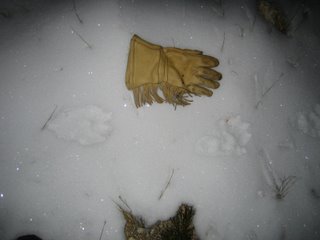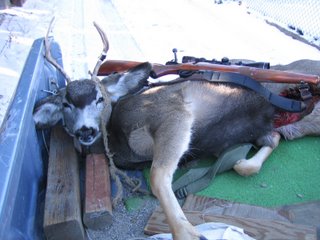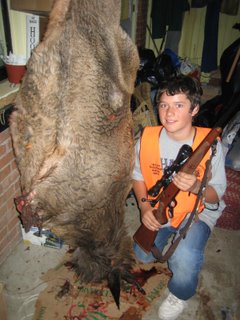
Elk season is like moonlighting at a second job.
Opening day (Sunday two weeks ago) found AJ and I high up on a ridge along the Continental Divide. The pic at left shows our view at sunrise: a valley filled with icy fog, and the peaks of the Pintler Wilderness like islands across a sea.
Several groups of hunters had put camps into this area, and it seems to have move the elk out. We did see some late in the day as we glassed through binoculars to ridges a mile or so away.
Over the course of the week, I got out once or twice more. One morning I drove a forest road up a Big Hole tributary, parked at about 7,500 feet, and hunted the whitebark pines and scree edges. The snow had warmed and refrozen and so was very noisy. But I used my time well, and spent the day following a large black bear track (see pic, below).

Though I never caught up with or glimpsed the bear, it was interesting seeing where it had raided squirrels' nut caches and crossed rugged areas of scree (see pic, below).

It was a glorious day to be in the mountains, and when the snow warmed up and quieted down, I said goodbye to the bear and walked down a ridge above the east side of the drainage where I had parked. I would walk a few steps, lean against a tree, pause, smell, listen, and glass the trees and deadfall. In the past I have found elk bedded on this ridge.
This day, however, they had crossed from the north side of the ridge just ahead of me. I smelled them and then saw the fresh tracks in the snow. I began following, but within an hour the day began to cool, the snow again settled into a noisy crust, and when I did get close to the elk they ran on ahead.
A day or so later I hunted another familiar place -- on a "low" ridge (7500 feet) along the Big Hole River. I hoped the snow would be quiet on the north slope and allow me to stalk closely to a bedded elk. The snow was quiet but the wind swirled and shifted. The elk -- a large, lone bull -- twice circled ahead of and above me and (as I knew from reading the tracks) watched me pass by.
 A week ago Saturday I hunted mule deer in the lower Big Hole with AJ, and mildly chastised him for missing two bucks. It was his first time shooting at big game, and he might have been a little excited. On Sunday he hunted with a family friend, so I hunted deer alone and shot a fat little forkhorn ( see pic at left). I saw a larger buck on the backside of the ridge, but shooting it would have meant (A) a big stinky mulie buck; and (B) fording across the river with the carcass to reach the nearest road. I wanted to be home by noon and those little bucks are tasty.
A week ago Saturday I hunted mule deer in the lower Big Hole with AJ, and mildly chastised him for missing two bucks. It was his first time shooting at big game, and he might have been a little excited. On Sunday he hunted with a family friend, so I hunted deer alone and shot a fat little forkhorn ( see pic at left). I saw a larger buck on the backside of the ridge, but shooting it would have meant (A) a big stinky mulie buck; and (B) fording across the river with the carcass to reach the nearest road. I wanted to be home by noon and those little bucks are tasty.This past Saturday we set off on a favorite hunt. Parking at a pass along the Divide, we hiked east a mile and then set off north down a ridge that parallels the highway for about five miles. We jumped elk at first light, and they ran across the high shallow valley to two hunters on horses where one cow was shot. The elk ran back to a ridge across from us and whistled several times. The snow was so noisy that a stalk would have been futile.
We continued down the ridge, turning our faces from a harsh 40 mph wind, and dropped into an isolated but sheltered spot where some loggers lived in drafty, tiny cabins 120 years ago when they were cutting cordwood for the Anaconda copper smelter. This is a big wide-open landscape, and only in the past 20 or so years has it begun to recover from the horrible effects of clear-cutting, acid smelter smoke poisoning, and soil erosion. Still a bit of a moonscape, there are also lush patches of bunch grass and thickly wooded bedding areas.
Just above the cabins we moved 200 yards apart through one such bedding area. A cow and calf moose nearly ran me over, and I saw one of the largest bull moose tracks I've ever seen in Montana. I also disturbed a band of elk and they ran behind AJ. He heard and saw them, but wisely did not hazard a shot at hard-to-see elk running full tilt through thick timber. We rested out of the wind, ate a snack near one of the cabins, and planned how we would hunt a high ridge to our east.
We climbed to the south end of the ridge, and AJ went along the "front" (west) side to seek out a sheltered spot to sit and watch the north end of the ridge. I went along the back side and moved through a dense stand of whitebark pines. There was abundant mule deer and elk sign. A bunch of mulie does ran past me, and when I heard AJ shoot, I worried that perhaps he had shot a mule deer buck. This is a long, long, ways to haul a deer.
But he excitedly ran down to me, explaining that about 20 elk had crossed the ridge. He was not going to shoot because they were all in full gallop, but three paused momentarily and he had taken aim on a cow. And he had shot her. A good shot, from about 200 yards away. From the foamy pinkish blood I knew it was a lung hit. As we carefully and slowly followed her down the steep slope, she left a good blood trail. Periodically, there were great gushes of blood, and I theorized that it was a high lung shot, and that the chest would fill with blood and then she would blow it out. As AJ followed the blood trail through thick cover, I circled out to the edges just in case she broke out. But she did not, and when AJ got to the bottom I heard him shoot again. He had found the cow down and unable to stand, and had taken a finishing shot. I congratulated him on this first kill, and we paused to admire and thank the elk.
I removed the ivory tusks, handed them to him, and explained their significance as a memory and treasure from the hunt.
"Now the work begins," I found myself saying--just as my grandfather said countless times to me after shooting a whitetailed deer on some Allegheny ridge. AJ made neat work of the field dressing, with a little instruction and a guiding hand. He removed the tenderloins, set them aside with the liver and heart, and we rolled the carcass over. He split it along the spine and removed the backstrap from each side. I then used my little hatchet to snicker-snack the ribs away from the spine and to finish splitting the carcass at pelvis and brisket.
We dragged each half to a shaded, snowy spot, and covered the meat with branches from a Douglas fir. then loaded our knapsacks with backstrap and tenderloin and liver and heart, and began the trek out.
Sunday we returned with my game sled and I threw the backpacks in the truck, "just in case." We dragged the first half out with the sled, which was hell: dry ground, grass, willow & alder thickets, and aspen stobs & deadfall along the beaver dams. It took three hours. So for the second half we brought the backpacks and AJ built a nice warming fire while I boned out the meat. This was much easier, given the dry and rugged trail out. We made it out of the canyon at dark, hung the elk half and put the bags of boned out meat in my mudroom. (see pic, below) Yesterday I picked up AJ after school and we cut & wrapped the first half. Today we'll cut & wrap the second half. Tomorrow or the next day we'll grind the scraps into sausage.
 AJ is a happy hunter, and a little bit lucky to have killed an elk in his 2nd day of hunting. His family will have about 150 pounds of meat in the freezer. Prime, tasty, and "all natural." And as the oldtimers say (God, I think I'm turning into an oldtimer), the harder it is to get an elk out of the woods, the better it tastes.
AJ is a happy hunter, and a little bit lucky to have killed an elk in his 2nd day of hunting. His family will have about 150 pounds of meat in the freezer. Prime, tasty, and "all natural." And as the oldtimers say (God, I think I'm turning into an oldtimer), the harder it is to get an elk out of the woods, the better it tastes.Later this week, I think my body has recovered enough to go elk hunting for myself. And we still need to find AJ a mulie buck to top off his family's freezer.

1 comment:
Hey Pat,
Matt hunted hard this year and commented that he has learned so much about the places he's been hunting by walking the hills with a gun in his hand. He commented, and I agreed, that it is much different knowing the land than knowing rivers. This whole conversation reminded me of an ongoing conversation we've had about knowing place through leisure and/or through labor. Thanks for your stories.
Post a Comment